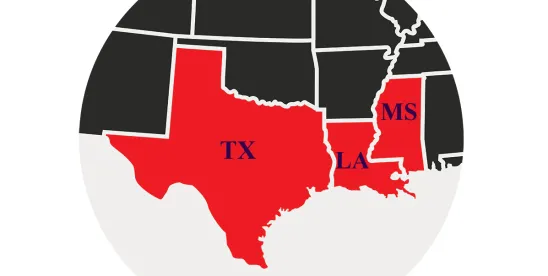Summary
A recent filing by the U.S. government in a pending Eastern District of Texas litigation signals a renewed interest by the current administration in potentially reviving the ability for non-practicing entities (“NPE”) to obtain preliminary injunctions for claims of patent infringement. On June 24, 2025, the U.S. government filed a “statement of interest” in Radian Memory Systems, LLC v. Samsung Electronics Co., providing both policy and legal arguments that NPEs may be entitled to preliminary injunctions in certain situations. The government’s statement demonstrates a policy shift in the current administration and may be an indicator that the de facto rule preventing NPEs from obtaining preliminary injunctions may be under new scrutiny. Suffice to say if the current administration is arguing that a NPE can obtain a preliminary injunction it may signal an increase ability for a practicing entity in obtaining a preliminary injunction against a competitor.
Discussion
On December 23, 2024, Radian Memory Systems, a NPE, filed a complaint for patent infringement and subsequently sought a preliminary injunction based on its allegations that “Samsung—a top-tier member of NVM Express (NVMe), which was developing standards in the SSD space—organized others in the industry to try to pressure Radian to join” but after Radian refused, “members [of NVMe] (including Samsung) began infringing upon Radian’s patented technology.” Id. at 4.
On June 24, 2025, the government filed a statement of interest under 28 U.S.C. § 517. See Radian Memory Systems, LLC v. Samsung Electronics Co., Case No. 2:24-cv-1073, Dkt. 52 (E.D. Tex. Jun. 24, 2025) (“SOI”). The government’s statement of interest—which took no position on whether the court should ultimately grant Radian’s request for a preliminary injunction—requested that the court place significant emphasis on the “unique” nature of patents and the resulting difficulty in calculating damages from patent infringement when determining the likelihood of irreparable harm under the current eBay four-factor analysis. See eBay Inc. v. MercExchange, L.L.C., 547 U.S. 388, 393-94 (2006). The government’s statement represents the Antitrust Division’s newly-articulated view that “[t]he incentive to innovate at the heart of the Patent Act is undermined when the availability of preliminary injunctions to block infringement is unduly limited” by the four-factor eBay analysis.
Radian’s motion for a preliminary injunction, which levied both allegations of patent infringement as well as anticompetitive behavior, presented an opportunity for the government to address the incentives created by eBay. The government’s statement of interest did so by citing to both legal and policy issues implicated by the current analysis under eBay. First, the government critiqued the current longstanding practice of the Federal Circuit’s adoption of Justice Kennedy’s concurrence in eBay—which all-but eliminates the ability of NPEs to obtain preliminary injunctions—as a de facto categorical rule. See SOI at 12 (citing eBay, 574 U.S. at 395-96 (finding that a patentee’s use of its patent not for producing and selling goods—but instead for obtaining license fees—presented a consideration outside of historical practice)). Specifically, the government asserts that patentees, including NPEs, should be afforded a greater weight to the “likelihood of irreparable harm” eBay factor due to the difficulty in properly calculating the potential for damages in patent cases.
Second, the government raises the antitrust policy concerns of protecting “Little Tech” and “small businesses and innovators” against the “serious potential for anticompetitive harm” inherent in large corporations and standards-development organizations.[1] For example, the government cites to an example where infringers of an NPE’s patent are incentivized “not to pay now when the worst-case scenario is having to pay later” because there is no equitable remedy available for the NPE. SOI at 15.
The government’s statement was eventually mooted by the Radian’s withdrawal of its motion, preventing a decision on the issue. Without a decision, only time will tell if the government’s arguments were made in response to the specific factual issue relating to Radian’s refusal to join the NVMe standards organization, or if there is a true shift in policy under the new administration. Thus, practitioners should continue to monitor similar cases to see if the government will seek another opportunity to bring this issue to a decision. If that happens and courts open the door for NPEs to obtain injunctions once again, the effects would be profound. For large corporations, the threat of a preliminary injunctions places more weight on quickly assembling a proactive and aggressive defense in the early stages of litigation. Patentees, however, could induce more pressure in the early stages of litigation and drive-up potential licensing values with the threat of an injunction looming. For these reasons, the industry will continue to monitor the government’s policy and whether the courts will be receptive to its arguments.
[1]The government’s statement of interest declares that “[t]he United States has an interest in encouraging innovation not only from large firms, but also from ‘Little Tech,’ which includes ‘small businesses and innovators.’” Statement of Interest at 2 (citing Abigail Slater, Assistant Att’y Gen., U.S. Dep’t of Just. Antitrust Div., Address at University of Notre Dame Law School (Apr. 28, 2025), https://www.justice.gov/opa/speech/assistant-attorney-general-gail-slater-delivers-first-antitrustaddress-university-notre).





 />i
/>i
